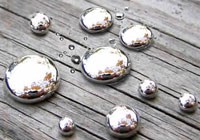
GoldSymbol: Au Uses: Gold is the most malleable and ductile of all metals. A single troy ounce of gold can be beaten into a flat sheet measuring roughly 5 meters on a side. Thin sheets of gold, known as gold leaf, can be as thin as 0.000127 millimeters, or about 400 times thinner than a human hair. Pure gold is soft and is usually alloyed with other metals, such as silver, copper, platinum or palladium, to increase its strength. Gold alloys are used to make jewelry, decorative items, dental fillings and coins. Gold is a good conductor of heat and electricity and does not tarnish when it is exposed to the air, so it can be used to make electrical connectors and printed circuit boards. Gold is also a good reflector of infrared radiation and can be used to help shield spacecraft and skyscrapers from the sun's heat. Gold coated mirrors can be used to make telescopes that are sensitive to infrared light.
Measurements Precious metals like gold are measured in troy ounces and troy pounds. The troy ounce is approximately 10% heavier than a typical grocery store (avoirdupois) ounce. A troy pound weighs approximately 17% less than a grocery store pound. History: 
SilverSymbol: Ag Uses: History: 
MercurySymbol: Hg Uses: Mercury was often used in thermometers, barometers, and some electrical switches, but concerns about the element's toxicity has led to many of these uses to end. History: Many early alchemists viewed mercury as the First Matter from which all other metals were formed. They believed different metals, including gold, could be produced by varying the quantity and quality of sulfur and mercury. From the mid-18th to the mid-19th centuries, a mercury compound, mercuric nitrate, was used in the making of felt hats. This process separated the fur from the pelt and matted it together. This solution and the vapors it produced were highly toxic. The psychological symptoms associated with mercury poisoning are said by some to have inspired the phrase "mad as a hatter." 
Fool's GoldSymbol: FeS2 Uses: |
Last updated: December 31, 2019
